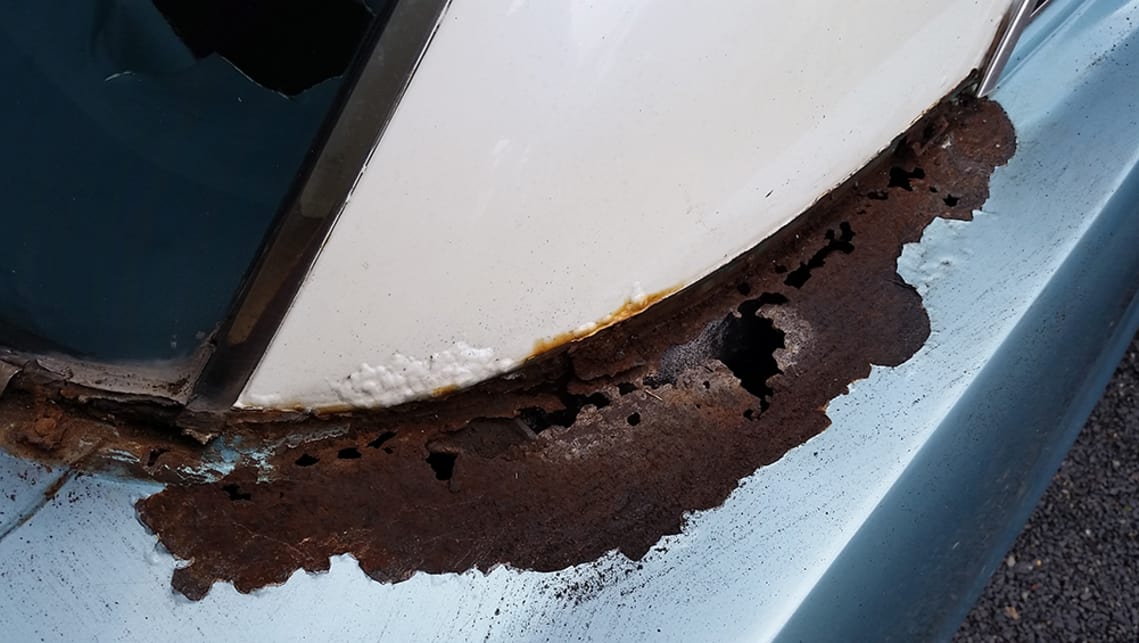9 Best Rust Removal And Restoration Techniques for Cars include sanding, grinding, chemical rust removers, naval jelly, electrolysis, rust converters, wire brushes, vinegar, and mechanical methods like blasting. Each technique serves a unique purpose in removing rust and restoring the car’s exterior.
Different methods may be more effective depending on the extent of rust damage and the type of metal surface. It is crucial to choose the appropriate technique for the best results and to ensure long-lasting restoration of the vehicle’s bodywork.
Following these techniques will help car owners maintain the aesthetic appeal and structural integrity of their vehicles, prolonging their lifespan and preserving their value.
Chemical Rust Removers
When it comes to removing rust from your car, one of the most effective methods is by using chemical rust removers. These products are specifically formulated to dissolve rust and restore your vehicle’s metal surfaces to their former glory. In this article, we will explore the best chemical rust removal techniques for cars, starting with acid-based removers and focusing on phosphoric acid products.
Acid-based Removers
Acid-based rust removers are highly effective at breaking down rust and eliminating corrosion from metal surfaces. These products contain acids that react with the rust, loosening its grip and allowing it to be easily removed. Among acid-based removers, phosphoric acid products are widely recognized for their outstanding results and safety.
Phosphoric Acid Products
Phosphoric acid is a common ingredient in many rust removal products due to its powerful rust-dissolving properties. This acid effectively converts iron oxide (rust) into a more stable compound that can be easily removed. Phosphoric acid-based rust removers not only get rid of rust, but they also create a protective coating that prevents further corrosion.
One popular phosphoric acid rust remover is Naval Jelly. This thick gel-like substance is easy to apply and clings to vertical surfaces, making it perfect for hard-to-reach areas of your car. Simply apply Naval Jelly to the rusted surface, let it sit for the recommended time, and then rinse it off with water. You’ll be amazed at how the rust disappears, leaving behind a clean and restored surface.
Another effective phosphoric acid product is Evapo-Rust. Unlike many other rust removers, Evapo-Rust is non-toxic and safe to use. It works by immersing the rusted parts in the solution, allowing the acid to penetrate and dissolve rust. After a few hours, just rinse the parts with water, and you’ll see the rust vanish before your eyes.
For those who prefer a convenient spray-on option, Rust-Oleum Rust Dissolver is an excellent choice. This phosphoric acid-based formula comes in a spray bottle, allowing you to easily apply it to large rusted areas. The powerful acid penetrates the rust, breaking it down and making it simple to wipe away.
To summarize, chemical rust removers are a fantastic option for restoring your car’s metal surfaces. Acid-based products, especially those containing phosphoric acid, are known for their effectiveness and ease of use. Whether you choose Naval Jelly, Evapo-Rust, or Rust-Oleum Rust Dissolver, you can say goodbye to rust and hello to a rejuvenated car.

Credit: www.ebay.com
Mechanical Rust Removal
Mechanical rust removal techniques are effective in restoring the beauty of your car’s body.
Wire Brushing
Wire brushing involves using a stiff wire brush to scrub away surface rust from metal surfaces.
Sanding
Sanding utilizes sandpaper or sanding discs to smooth out and remove rust from the affected areas.
Electrolysis Rust Removal
Rust is a common issue for car owners, but Electrolysis Rust Removal is a highly effective technique to tackle this problem. By utilizing the principle of electrolysis, you can efficiently remove rust from metal surfaces, leaving your car with a clean and restored look.
Diy Electrolysis Setup
To set up an electrolysis rust removal system at home, you will need a few basic materials:
- Plastic container
- Washing soda (sodium carbonate)
- Power source (battery charger)
- Anode (non-rusting metal)
- Cathode (part to be de-rusted)
- Water
Rust Removal Using Electrolysis
When setting up the electrolysis system, ensure the part to be cleaned (cathode) is fully submerged in the solution. Connect the part to the negative terminal of the power source and the anode to the positive terminal. Let the process run for a few hours to remove the rust effectively.
Credit: www.leonsautobody.com
Conversion Coatings
Conversion coatings are an effective rust removal and restoration technique for cars. The process involves treating the metal surface to create a protective layer that prevents further corrosion. This method is commonly used to prepare the surface for painting or additional protective coatings, ensuring long-lasting results.
Conversion Coatings
Conversion coatings are an essential part of rust removal and restoration techniques for cars. These coatings chemically convert rust into stable compounds, providing a protective layer that prevents further corrosion. Implementing conversion coatings not only eliminates visible rust but also extends the lifespan of the car’s body. In this section, we will explore two effective conversion coatings: Primer Application and Rust Converter. Let’s dive right in!
Primer ApplicationPrimer Application
One of the most effective rust conversion methods is primer application. Before applying a primer, it is crucial to clean the affected area thoroughly. Start by removing any loose rust particles using a wire brush or sandpaper. Then, use a cloth soaked in a mild detergent solution to wipe away any dirt or grime. Once the surface is clean and dry, apply a high-quality rust-inhibiting primer using a brush, roller, or spray gun. A primer creates a strong bond between the metal surface and subsequent paint layers, providing excellent protection against rust formation.
Rust ConverterRust Converter
Another popular method for rust removal and conversion is the use of rust converters. Rust converters are acid-based solutions that chemically react with rust, transforming it into a stable compound. These solutions are typically applied using a brush or spray bottle directly onto the rusted surface. As the solution reacts with the rust, it forms a black, corrosion-resistant layer, effectively stopping further rusting. Rust converters are particularly useful for large areas affected by deep rust, and they can be used as a standalone protective coating or as a primer before painting.
Diy Natural Rust Removal Methods
When it comes to removing rust from your car, DIY natural methods can be effective and eco-friendly. These methods utilize common household items to tackle rust without using harsh chemicals. Let’s explore two popular DIY natural rust removal methods:
Vinegar And Baking Soda
Vinegar and baking soda form a powerful combination for natural rust removal. Here’s how to use them:
- Mix equal parts vinegar and baking soda to form a paste.
- Apply the paste to the rusted areas and let it sit for a few hours.
- Scrub the area with a brush or scrubbing pad to loosen the rust.
- Rinse the area thoroughly and repeat the process if necessary.
Potato And Dish Soap
Potato and dish soap may seem like an unlikely rust removal solution, but the oxalic acid in potatoes can help break down rust:
- Cut a potato in half and dip it in dish soap.
- Scrub the rusted areas with the potato, reapplying dish soap as needed.
- Rinse the area and repeat the process until the rust is removed.

Credit: www.carsguide.com.au
Frequently Asked Questions On 9 Best Rust Removal And Restoration Techniques For Cars
What Is The Best Rust Remover For The Vehicle?
The best rust remover for your vehicle is a product that contains phosphoric acid or oxalic acid, as these are effective in breaking down rust. Make sure to choose a rust remover that is safe for your vehicle’s surface and follow the instructions carefully for best results.
What Is The Best Treatment For Rust On Cars?
The best treatment for rust on cars is to sand down the affected area, apply a rust converter, primer, and paint. Regular maintenance and keeping the car clean can prevent future rust.
What Is The Fastest Way To Fix Rust On A Car?
The fastest way to fix rust on a car is to sand the affected area, apply a rust converter, fill in any holes or gaps with body filler, and then repaint the area. Regular maintenance and addressing rust early can prevent further damage.
What Is The Best Rust Dissolver On The Market?
The best rust dissolver on the market is [Brand Name]. It effectively removes rust from various surfaces, providing long-lasting protection. Its powerful formula tackles even the toughest rust, making it a reliable choice for rust removal. Say goodbye to rust with [Brand Name].
Conclusion
To sum up, these 9 rust removal and restoration techniques can effectively revive the appearance and condition of your car. By choosing the appropriate method based on the severity of the rust, you can ensure long-lasting protection and prevent further damage.
Remember to prioritize regular maintenance and applying protective coatings to keep your car looking its best. With these techniques in your arsenal, rust will be no match for your automotive restoration endeavors. Keep exploring and preserving the beauty of your beloved vehicle.
